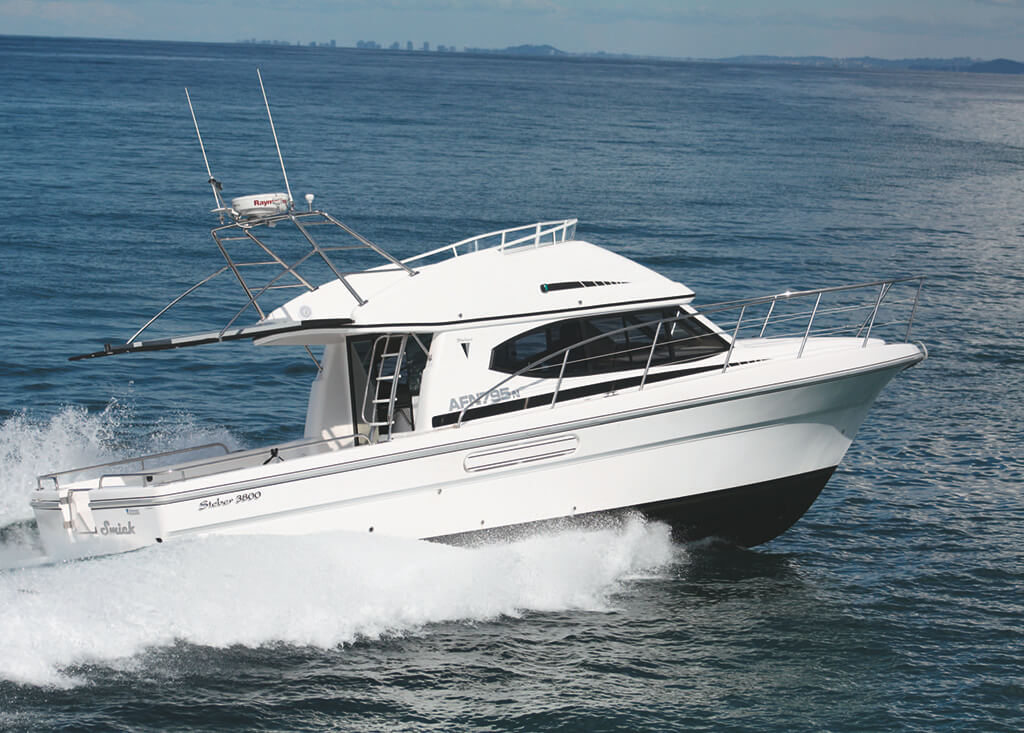Author : Barry Tyler
THE PERFECT MIX
While the Stebercraft range has enjoyed considerable success in commercial applications, right around the world, the latest Steber 3800 Flybridge Cruiser graphically confirms the fact you can still mix business with pleasure – by adding appropriate creature comforts!
While the Australian Marine industry has in many cases suffered mercilessly at the hands of the GFC, through it all Taree, Central NSW-based Steber International has struggled to keep up with the demand for its vessels. With an enviable reputation for building no-nonsense, dependable and durable craft that handle the worst of conditions in their stride, the winner from all this is the man in the street who wants a boat that won’t let them down, a boat that stands the test of time.
Yes it is common knowledge that Stebercraft builds substantially more commercial vessels than pleasure versions but for those who do make the decision to add the luxury appointments and the toys to match – they end up purchasing a vessel with attitude, which lasts a veritable lifetime. That’s precisely the reason the owners of this particular example chose their Steber; an extremely active business couple, they bought a vessel of the ilk of the Steber so they could leave the ‘rat-race’ well behind on as many weekends as could be squeezed into their hectic schedule.
Dependability though, was their key requirement and the fact they would find this in a pseudo commercial version mattered little to them; they could/would add their own lifestyle features! And add them they did, for the more I looked around this boat the more I came to appreciate the fact this was a very serious cruising boat which was purpose-designed to address recreational aspects such as fishing, diving, snorkelling, cruising and simply enjoying the confines of some secluded bay.
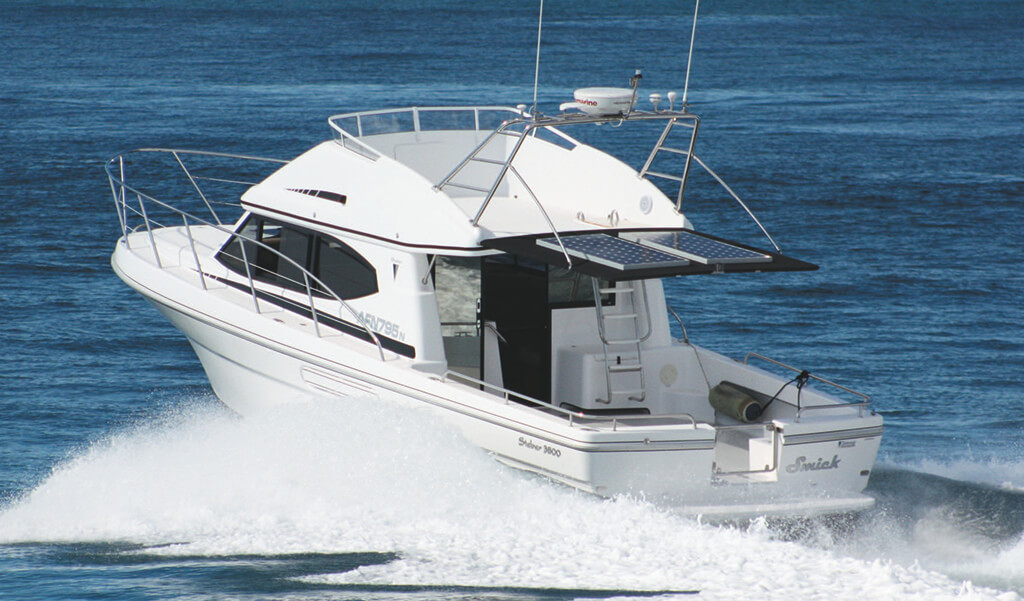
That was on the outside; inside in the saloon and accommodation area I was acutely aware of the reality that this particular example was so deliberately designed and appointed as a one-couple luxury boat; the saloon offered a galley suited to a couple, the dining setting was suited to a couple, and further forward and down two steps the one cabin, an ensuite cabin, again was wittingly designed for just the one couple.
Gargantuan Cockpit
I knew one day I would be able to use that word, for it is the one descriptive which perhaps best describes an aft cockpit that was sublime in dimension. Entering from the boarding platform, through a ‘proper’ transom door, the mind was in over-drive conjuring up images of just what this cockpit could be used for – other of course than just kicking back and enjoying the moment on one of the two corner lounges which surrounded the central drop-in cockpit table.
Rod-holders and lockers abounded on this version also, so I assumed it was also going to see the odd fish come over the side. Other features in the cockpit included the generously wide coamings with grab rails atop, huge engine hatches which provided access to the two engine bays, a cavernous aft lazaretto, a bulkhead refrigerator/freezer combo, a near-vertical but still easily accessible S/S ladder (with non-slip poly steps) up to the flybridge level, and a generous sized flybridge overhang or extension which provided a surprising amount of overhead protection from the elements.
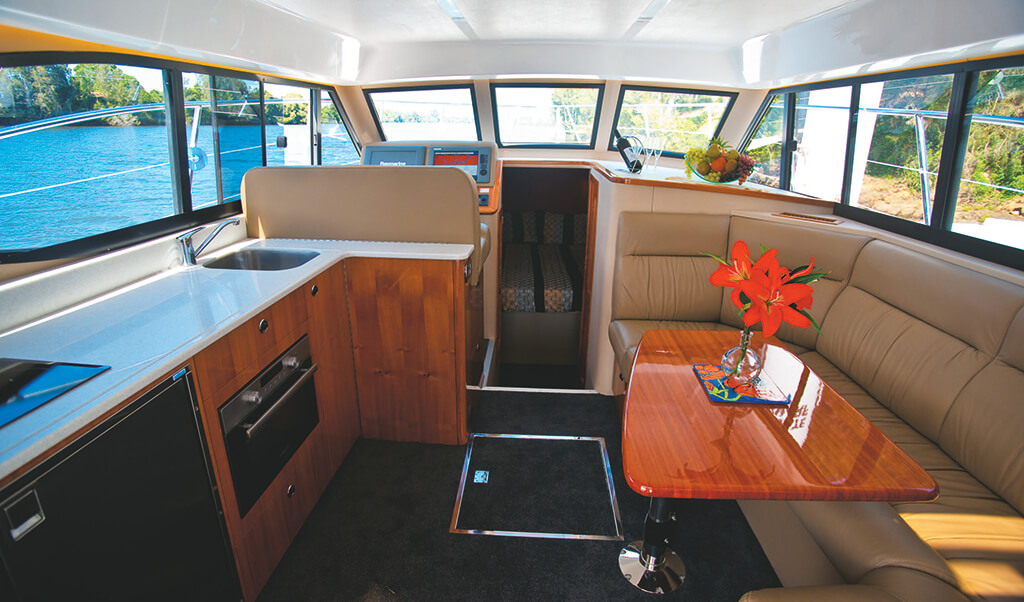
Interestingly, this couple were not fussed either way as to whether or not they had a flybridge but eventually, ostensibly for re-sale purposes, they opted for a version – without a helm station! They had other plans for this location, including firstly as a convenient place to house the inflatable when on a passage; secondly it was a good place to hang the overhead protection from the elements; and thirdly it provided a rather unique ‘privatised’ sunbathing area – out of the public gaze. Perfect!
For those who needed to venture up onto the foredeck, sensible steps each side lead up onto the sufficiently-wide walkways. The walk forward was aided nicely by the bow rail which extended well aft, but I must confess I would also have liked to have seen a grab-rail along the side of the cabin, to hang onto in heavy seas. Once up on the foredeck the safety aspect was however better addressed with the higher and more substantial bow rail, along with the cleverly secreted Muir VRC1250 winch and Sarca anchor – no tripping on them!
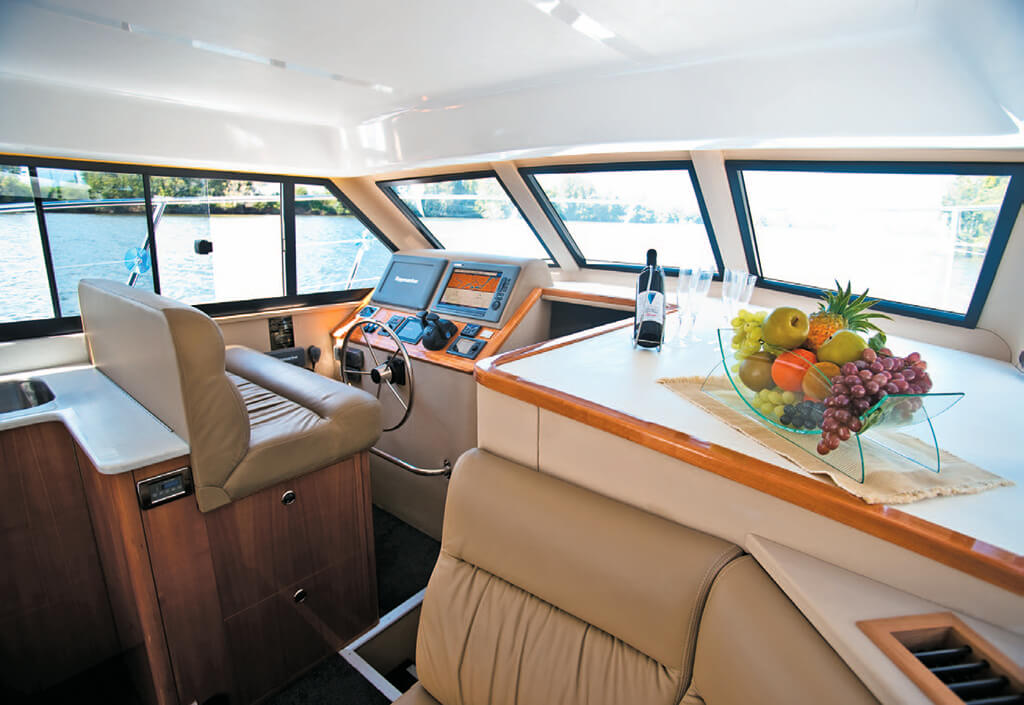
Comfortable, Practical Saloon
The two saloon doors with, may I add, a sensible hopper window alongside, provided an appropriate entry into a saloon seemingly perfect for extended-stay lifestyle living – ideally for two people. Elegant and classy without being gushy and demonstrative, décor in here was a durable yet still aesthetically pleasant mix of gelcoat, leather lounges, impressive windscreen mullions, full-gloss southern myrtle wood finish and plush vinyl panelling for the walls and bulkheads.
Off to portside was the L-shaped aft galley which included a deep sink, good bench space, good cupboard and drawer storage, and a two-burner electric cook-top with below it a Samsung electric oven and griller. Alongside the oven was very generous refrigeration capacity in the form of a side-by-side under-bench refrigerator plus freezer. The pop-up television was a clever piece of innovation too, in that not only did it pop up, but when it reached its full extension it also swivelled through 180-degrees – you could watch it from any angle!
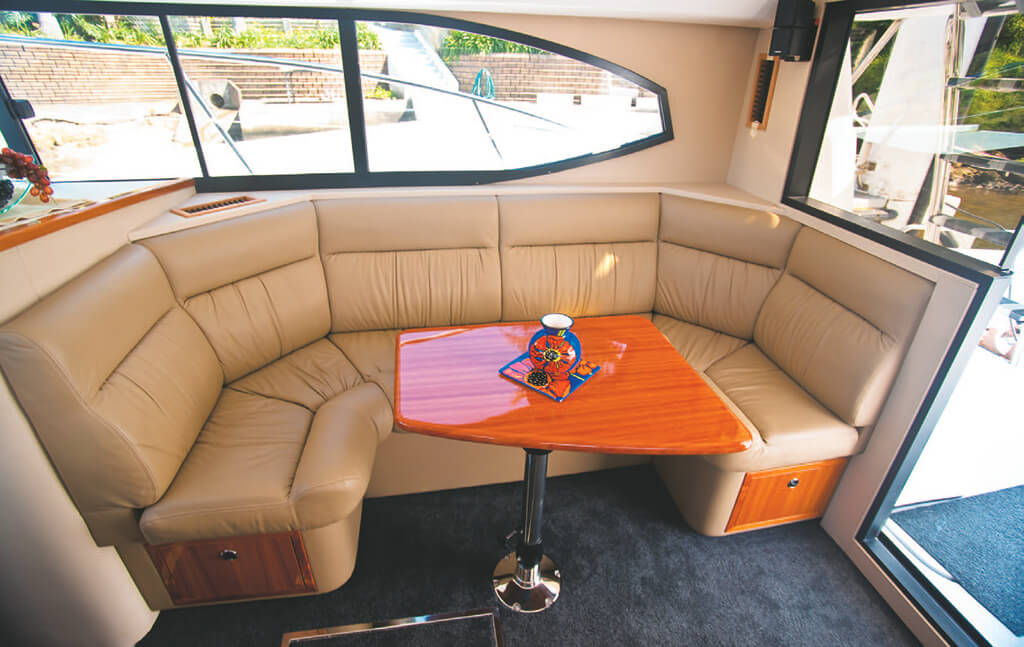
Other features within the saloon included the Fusion stereo and speakers, a pull-out pantry, pot drawers moulded into the base of the skipper’s bench seat, and good ventilation and cross-drafts (if you didn’t want to start the air-conditioning) thanks to the opening side windows, deck hatch in the cabin and the open nature of the aft entry doors. Yet more storage was available in the huge underfloor storage void alongside the helm, which was seemingly perfect for further food storage, wet gear or a dive compressor – the possibilities were limitless!
Directly opposite the galley was the U-shaped dining setting ideally for two (four at a pinch) – which came complete with storage provision in drawers within the base. If friends invited themselves along for the weekend, this dining setting lowered to conveniently transform into a second double berth.
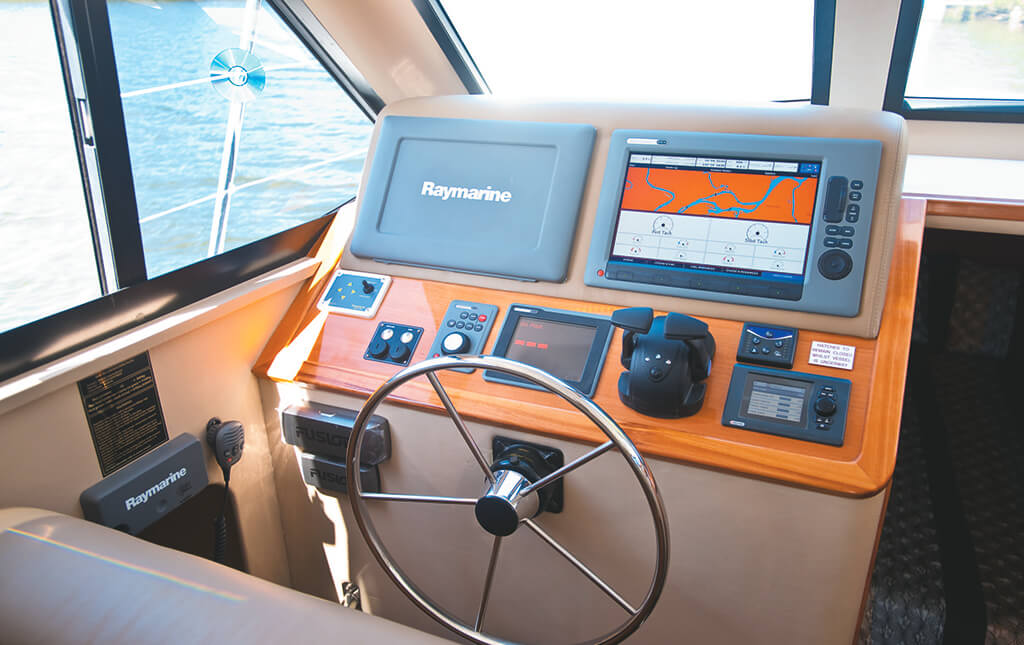
Clever Saloon Layout
Despite the inclusion in the saloon of the helm, this aspect was deceptively well secreted from the actual ‘living’ side. Seated (or standing if you so desired) at the Steber two-person bench seat, the skipper had before him/her what could best be described as an ergonomic, nicely presented most capable and all-encompassing array of instrumentation, remote controls and electronics including two of the latest Raymarine E140W touch-screens, and the CZone onboard vessel management system.
Alongside/opposite the helm station was a large structure or appendage, a bulkhead if you like, which again was well presented and well-secreted. I am going to suggest here that yes, this was thoughtfully or considerately intrusive on actual floor area in the saloon, but what it did do was afford Steber the flexibility to include an ensuite bathroom within the parameters of the forward cabin below.
As I make mention of in virtually every boat test article I write, everything on a boat is a trade-off; in this instance the trade-offs were the significantly larger cockpit which accrued by ‘situating’ the cabin perhaps further forward than is traditional in a 38-footer, the slightly smaller but well planned saloon, and this ‘ensuite’ cabin below decks. A generous-sized bathroom complete with separate head and shower, vanity, light and ventilation fan, of course this bathroom also doubled as the day head!
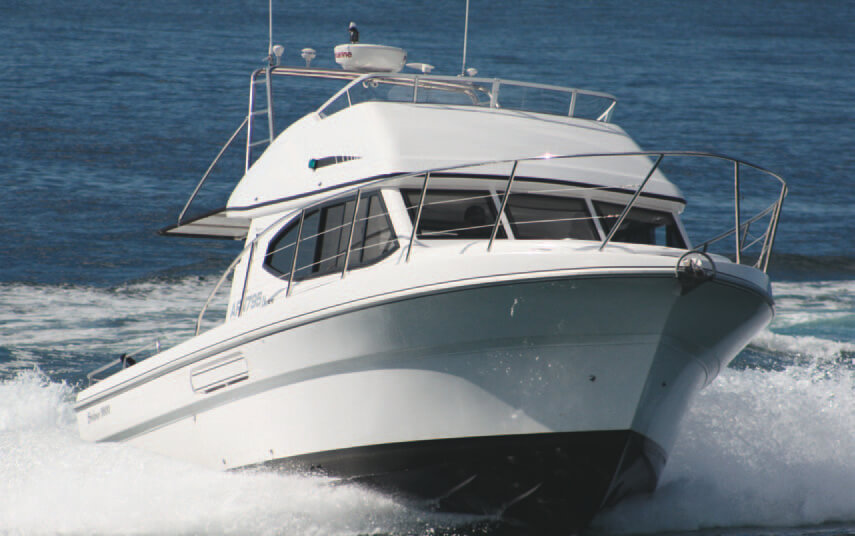
This accommodation up for’ard consisted of a queen-size island berth in the middle of a cabin which was practical and classy without being opulently flashy. Carpeted and featuring a Maxwell overhead hatch, good lighting, suede panelling and more of the brilliantly crafted southern myrtle woodwork, it was very much a ‘warm’ and peaceful area of the Steber.
Mechanicals
In the true tradition that has made Steber such a well respected brand, the mechanical inventory on the 3800 was matter of fact and to the point; there were no extraneous bells and whistles; everything was done properly! Centre of attention in the huge engine bays were the pair of 315hp inline 6-cylinder, 4-valve, 4.163-litre Yanmar 6LPA-STP diesel engines which ran through ZF-80A gearboxes and conventional shaft drives, to a pair of 23” x 27.5” Veem 5-blade propellers.
Meagre power one might well suggest, for a 12.2 metre, 11,500kg GRP hull, but it was surely a measure of the hull’s inherent efficiency that it reached a creditable top speed of 28 knots at the maximum 2800rpm. You wouldn’t run hard all day at that top speed – it cruises at anything from 16-22 knots – but it would surely be comforting for these owners to know that if the seas did cut up rough, they could be back home or indeed reach meaningful shelter, in a timely fashion.
Like the engines, the peripheral mechanical inventory was equally as impressionable, the owner in tandem with Stebercraft opting for efficiency and reliability rather than grandeur. For instance the three 150Ah 24V batteries feed through an inverter to the totally LED onboard lighting system, including the Aqualuma underwater lights. Cleverly, this Steber also ran a larger than traditional-sized inverter, so as to avoid a circuit breaker ‘tripping’ when the air-conditioning, jug, stove and whatever else, are all running simultaneously through the shore power medium. Yet again, well engineered and planned – first and foremost!
Other ‘cruising-orientated’ features obvious in these two engine bays, offering an explicit insight into the actual size of these bays, were the fuel (1350 litres) and water (210 litre) tanks, the 5kVA genset, a hot-water cylinder, the diesel heater for the cooler days (this owner boats all year round!), the 7kW air-conditioning, an SK 105L/h water maker, the 5kW Victron inverter and the banks of three house and two engine batteries.
The other power source was of course the two solar panels which I discovered quite by accident, that were neatly and again rather innovatively attached to the top side of the flybridge extension or overhang. Again ostensibly out of the public eye so to speak, this overhang which was capably supported off the S/S flybridge Targa/radar.
Getting down to tin tacks, the best part, the very real advantage in having a vessel of commercial heritage and competence, was the 3800’s inherent handling and performance characteristics. Efficiency was obvious through its speed capabilities but it was in the handling stakes where it really excelled. It was agile, very agile, it was deft in its ability to change direction and as I discovered in a subsequent test when the seas were significantly rougher (40-45 knots plus), it had no bad habits; as such it offered an indelible feeling of security. The rougher the conditions the more this Stebercraft revelled in them; it just loved the bigger seas, which is so important when you are marketing a vessel as a genuine bluewater one.
Conclusion
The Steber 3800 Sports Flybridge was what I would best describe as a good wholesome, go anywhere, do anything style of vessel – with pedigree and with attitude! Forget the fact this hull was born of a commercial heritage, for the people of Stebercraft have graphically proved they can build a boat with refinements that genuinely edge it into the luxury extended-stay category. Finish was very good, their mechanical expertise was evident throughout the vessel, and the best part I believe was surely the price-tag of $A720,000 – for a thoroughbred coastal cruiser with attitude!
TECHNICAL SPECIFICATIONS
- Boat Design Name: Steber 3800 Sports Cruiser
- Year Launched: 2010
- Designer: Stebercraft P/L
- Builder: Stebercraft P/L
- LOA: 12.2 metres
- LWL: 9.83 metres
- Beam: 3.84 metres
- Draft: 1.00 metres
- Displacement: 11,500 kg
- Max Speed: 28 knots
- Cruise Speed: 16-22 knots
- Construction: Hand-laid solid GRP
- Fuel capacity: 1350 litres
- Water capacity: 210 litres
- Engines: 2 x 315hp Yanmar 6LPA-STP
- Gearboxes: 2 x ZF-80A
- Drive train: Conventional shaft
- Propellers: Veem 23” D x 27.5” P
- Base price of boat: $A573,414
- Price as tested: $A720,000


